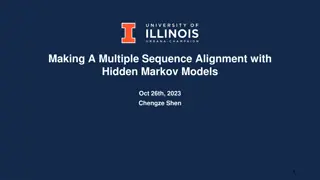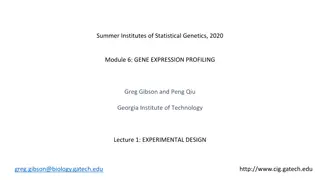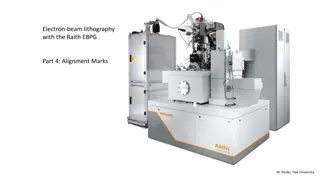Understanding Sequence Alignment in Next-Generation Sequencing Data
Sequence alignment plays a crucial role in analyzing Next-Generation Sequencing (NGS) data by identifying similarities between DNA, RNA, or protein sequences. Global and local alignment methods are used to arrange sequences and locate fragments derived from specific genes or transcripts. Challenges in NGS read alignment include alternative splicing, aligning billions of reads with mismatches, handling sequencing errors and biological variations, and addressing repetitive regions in eukaryotic genomes.
Download Presentation

Please find below an Image/Link to download the presentation.
The content on the website is provided AS IS for your information and personal use only. It may not be sold, licensed, or shared on other websites without obtaining consent from the author. Download presentation by click this link. If you encounter any issues during the download, it is possible that the publisher has removed the file from their server.
E N D
Presentation Transcript
Gene Expression Analyses Alignment of Next-Generation Sequencing Data Nadia Lanman February 26, 2019
What is sequence alignment? A way of arranging sequences of DNA, RNA, or protein to identify regions of similarity Similarity may be a consequence of functional, structural, or evolutionary relationships between sequences In the case of NextGen sequencing, alignment identifies where fragments which were sequenced are derived from (e.g. which gene or transcript) Two types of alignment: local and global http://www-personal.umich.edu/~lpt/fgf/fgfrseq.htm
Global vs Local Alignment Global aligners try to align all provided sequence end to end Local aligners try to find regions of similarity within each provided sequence (match your query with a substring of your subject/target) gap mismatch
Alignment Example Raw sequences: A G A T G and G A T T G 4 matches, 1 insertion 4 matches, 1 insertion 2 matches, 0 gaps 3 matches, 2 end gaps A G A T - G . A G A - T G . A G A T G A G A T G . . G A T T G . G A T T G G A T T G . G A T T G
NGS read alignment Allows us to determine where sequence fragments ( reads ) came from Quantification allows us to address relevant questions How do samples differ from the reference genome Which genes or isoforms are differentially expressed Haas et al, 2010, Nature.
Standard Differential Expression Analysis Differential expression analysis Check data quality Unsupervised Clustering Trim & filter reads, remove adapters Count reads aligning to each gene GO enrichment analysis Align reads to reference genome Check data quality Pathway analysis
Challenges of NGS Read Alignment Alternative splicing Often must align billions of reads Reads will have some mismatches = an approximate matching problem Sequencing errors True biological variation Eukaryotic genome are rich in repetitive regions` New methods had to be developed which were specific to NGS sequence alignment Multi-mapped reads
More than 90 aligners exist Bowtie2 BWA STAR Tophat2 Pseudo Aligners for RNA- seq quantification Kalliso Salmon Sailfish https://www.ecseq.com/support/ngs/what-is-the-best-ngs-alignment-software
BWA Burrows-Wheeler transform algorithm with FM-index using suffix arrays. Need to create a genome index BWA can map low-divergent sequences against a large reference genome, such as the human genome. It consists of three algorithms: BWA-backtrack (Illumina sequence reads up to 100bp) BWA-SW (more sensitive when alignment gaps are frequent) BWA-MEM (maximum exact matches) BWA SW and MEM can map longer sequences (70bp to Mbp) and share similar features such as long-read support and split alignment, but BWA-MEM, which is the latest, is generally recommended for high-quality queries as it is faster and more accurate. BWA-MEM also has better performance than BWA-backtrack for 70-100bp Illumina reads.
Bowtie2 Bowtie (now Bowtie2) is part of a suite of tools for analyzing RNA-seq data (Bowtie, Tophat, Cufflinks, CummeRbund) http://bowtie-bio.sourceforge.net Bowtie2 is a Burrows-Wheeler Transform (BWT) aligner and handles reads longer than 50 nt. Need to prepare a genome index Given a reference and a set of reads, this method reports at least one good local alignment for each read if one exists. Bowtie (now Bowtie2) is faster than BWA for some alignments but is sometimes less sensitive than BWA Can view all sorts of arguments for one or the other on SeqAnswers.com Langmead and Salzberg, 2012, Nat. Methods
STAR Splicing Transcripts Alignment to a Reference Two steps: Seed searching and clustering/stitching/scoring (find MMP -maximal mappable prefix using Suffix Arrays) Fast splice aware aligner, high memory (RAM) footprint Can detect chimeric transcripts Generate indices using a reference genome fasta, and annotation gtf or gff from Ensembl/UCSC. Dobin et al., 2013 Bioinformatics
Alignment Concepts and Terminology Edit distance Mapping quality: the confidence that the read is correctly mapped to the genomic coordinates Probability mapping is incorrect = 10-MQ/10 Proper pairs not not
Alignment Concepts and Terminology Read 2 Read 1 Read 1 Adapter Read 2 Adapter Insert size = the sequence between two adapters Fragment length = insert size + adapters Read 2 Adapter Read 1 Adapter Read 1 Read 2 Inner distance = the length of the inner part of DNA, not shown by reads
Insert size Find insert size and mean and median bamtools stats -i foo.bam insert Or samtools stats --insert-size foo.bam Or bbmap.sh ref=reference.fasta in1=read1.fq in2=read2.fq ihist=ihist_mapping.txt out=mapped.sam maxindel=200000 Or one of the many other options available (just Google) ..
Alignment Concepts and Terminology Multimapped reads: reads that align equally well to more than one reference location -How multimapped reads are handled depends on parameter settings selected, program, application, and how many time reads map to multiple places Duplicate reads: reads that arise from the same library fragment -How duplicates are handled also depends on parameter settings selected, program, application -Can arise during library prep (PCR duplicates) or during colony formation (optical duplicates)
Mappability Not all of the genome is available for mapping when reads are aligned to the unmasked genome. Uniqueness: This is a direct measure of sequence uniqueness throughout the reference genome. Rozowsky, (2009)
FASTQ Format Text files containing header, sequence, and quality information Quality information is in ACII format Q = -10 log10p https://www.drive5.com/usearch/manual/fastq_files.html
BAM and SAM format SAM file is a tab-delimited text file that contains sequence alignment information BAM files are simply the binary version (compressed and indexed version )of SAM files they are smaller Example: Header lines (begin with @ ) Alignment section
Understanding SAM flags https://broadinstitute.github.io/picard/explain-flags.html
Processing SAM/BAM files SAMtools is a software suite which provides various utilities for manipulating alignments in SAM format Sorting, merging, indexing, and generating alignments in a per-position format import: SAM-to-BAM conversion view: BAM-to-SAM conversion and sub alignment retrieval sort: sorting alignment merge: merging multiple sorted alignments index: indexing sorted alignment faidx: FASTA indexing and subsequence retrieval tview: text alignment viewer pileup: generating position-based output and consensus/indel calling RSamTools package in Bioconductor allows similar functionality in R.
Observe Data in a Genome Browser known genes forward reverse known genes forward reverse known genes
Observe Data in a Genome Browser alternative splicing differential expression known genes forward reverse known genes forward reverse known genes noise or regulation? unannotated gene
Quantifying Genes Now that alignment has been performed, reads can be counted and a matrix created, quantifying genes and transcripts Many techniques exist HTSeq-Count FeatureCounts RSEM Pseudoaligners
Demonstration 1. Download public dataset from a repository 2. STAR alignment of RNA-seq data 3. SAMtools
Setup your workspace #login to Scholar and go to scratch space ssh username@scholar.rcac.purdue.edu cd $RCAC_SCRATCH #copy folder cp r /scratch/scholar/natallah/BioinfLecture_2019 ./ #make your own workspace mkdir myWork cd myWork mkdir genome mkdir indices mkdir fastqFiles mkdir annotation mkdir STAR_align
Download Genome Sequence Reference genomes can be downloaded from UCSC, Ensembl or NCBI genome resources. Here s the UCSC genome browser url for the human reference GRCh38: http://hgdownload.soe.ucsc.edu/goldenPath/hg38/chromosomes/ cd genome wget ftp://ftp.ensembl.org/pub/release- 77/fasta/homo_sapiens/dna/Homo_sapiens.GRCh38.dna.primary_assembly.fa.gz gunzip Homo_sapiens.GRCh38.dna.primary_assembly.fa.gz cd ../
Download Annotation if your reference genome is from Ensembl get GTF file from Ensembl otherwise get from UCSC table browser cd annotation wget ftp://ftp.ensembl.org/pub/release- 90/gtf/homo_sapiens/Homo_sapiens.GRCh38.90.gtf.gz gunzip Homo_sapiens.GRCh38.90.gtf.gz head Homo_sapiens.GRCh38.90.gtf cd ../
Copy Data cd fastqFiles cp ../../BioinfLecture_2019/fastqFiles/* ./ cd ../
STAR alignment of RNA-seq data Generate genome indices: cd indices cp ../../BioinfLecture_2019/indices/star_build.sub ./ edit paths in star_build.sub file (for example change /scratch/scholar/natallah/BioinfLecture_2019/indices to /scratch/scholar/username/myWork/indices) qsub star_build.sub qstat | grep username qdel jobID.scholar-adm cd ../ mkdir indices2 cp ../BioinfLecture_2019/indices/* indices2
STAR alignment of RNA-seq data Align reads to genome cd STAR_align cp ../../BioinfLecture_2019/STAR_align/star.sub ./ edit path names (make sure your genome folder directory is indices2 and change BioinfLecture_2019 to myWork) qsub star.sub qstat | grep username cat star.sub.*
SAMtools # look at the first 10 lines of your SAM file module use /apps/group/bioinformatics/modules/ module load samtools head severe10Aligned.out.sam #convert to BAM samtools view -bT ../genome/Homo_sapiens.GRCh38.dna.primary_assembly.fa severe10Aligned.out.sam > severe10Aligned.out.bam Sort BAM file samtools sort severe10Aligned.out.bam -o severe10Aligned_sorted.bam























